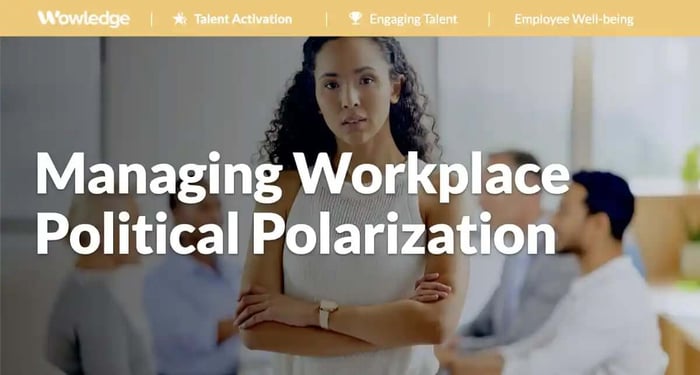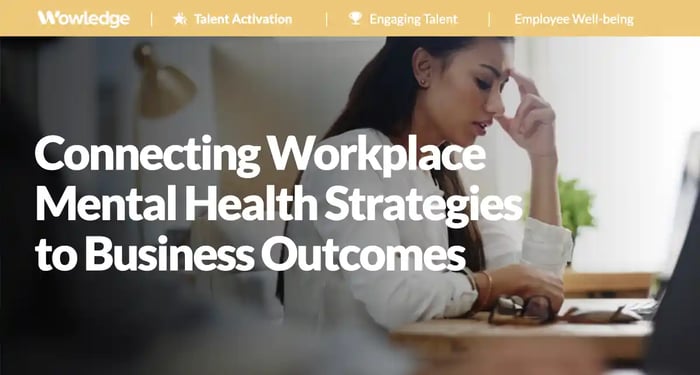Table of Contents
- Understanding the emotional basis for political beliefs
- Politics at work
- The realities and factors influencing workplace political polarization
- Risks and considerations for managing workplace political polarization
- Creating an environment that solves for and better manages workplace political polarization
- Relevant Practices & Tools
- About Wowledge
When one considers all of the non-business related challenges that corporate and HR leaders have had to deal with that disrupted their plans and ongoing operations—think global pandemic, financial market meltdown(s), weather/climate disasters, terrorist attacks, and social unrest/riots, having to deal with political polarization in the workplace was probably low on the list of predictions. However, with half of the US population supporting or leaning towards one party or the other, and heightened emotions being stoked to convince voters to choose one side or the other, it was perhaps inevitable that workplace political polarization would seep into organizational environments.
According to Gallup, the portions of the population considering themselves purely Republican or Democrat are equal at 28% each. While both parties are near their historic low points in unlearned party affiliation, adding in the independents who “lean” one way or the other, the totals come out as 46% Republican leaning and 45% Democratic leaning. While such a balance might seem innocuous in a vacuum, the foundations of political leanings tell a more concerning story for workplace political polarization.
Understanding the emotional basis for political beliefs
Organizations face the problem that individual political positions are emotionally based. They are therefore subject to the all-too-human tendency towards reactions or motivations driven by the “heart” rather than the “head.” In other words, reason does not necessarily prevail when encountering positions, statements, or actions that do not align with their own.
For example, research has found strong links between individual emotions and political allegiances, perceptions, and biases. It has been demonstrated that highly charged emotional reactions and behaviors can result when institutions such as the government adopt politically and socially charged positions, platforms, and decisions contrary to individuals’ beliefs. These reactions occur on both sides of the political spectrum (conservative and liberal) and should not be dismissed.
Dartmouth College’s Polarization Research Lab has reported that 56% of the surveyed population is “strongly polarized,” to the extent that 34% of respondents are willing to support 'democratic norm violations' to resolve such conflicts. This gives people more reason and motivation to speak out in support of their beliefs, creating conditions ripe for workplace political polarization. Corporate leaders must be cognizant of the strength of these emotions, the extent to which they can be disruptive to productivity, collaboration, and the achievement of operational goals, and be prepared to deal with the behaviors and actions of their employees in the workplace.
Politics at work
Workplace political polarization represents a critical concern for business and HR leaders. Start with findings of the extent to which political discussion occurs between colleagues. Gallup found that 45% of surveyed workers had discussed politics at work, with 54% of onsite workers and 48% of hybrid workers reporting such conversations (only 28% of remote employees stated the same).
Gartner reported an even greater rate of occurrence, with 78% of employees stating that they discussed politics at work, and that it escalates in the run-up to national presidential elections. Most concerning is the observation that those conversations impacted their ability to work effectively. For example, 36% of surveyed workers said that the topic of elections led them to avoid talking to or working with a coworker because of their political views, and 31% reported that their conversations were stressful and/or frustrating. Even more concerning is the finding that 29% of employees had witnessed unacceptable treatment of a coworker due to their political beliefs, including offensive name-calling, being avoided by colleagues, or being mistreated.
A SHRM survey found that 44% of U.S. workers experienced political disagreements in their workplace. Gallup’s surveys reported that, not surprisingly, younger workers (who tend to be more politically liberal) reported higher levels of discomfort than their older coworkers. Such unease seems to be shared by many, as other studies have established that 55% of employees believe that sharing political views can harm work relationships. 25% of surveyed employees report avoiding a coworker due to differing political views, and many add that they avoided getting help from a colleague based on their stated social or political positions.

The realities and factors influencing workplace political polarization
External forces and events drive internal discussion
Political, social, and climate occurrences that impact business operations, objectives, and plans naturally demand attention and a need for discussion. Think about how the impact of global trade agreements, relationships, supply chains, facility closures and damage, and transportation disruptions requires cross-functional solution development. Each of these, in turn, creates an opportunity for employees to engage in conversations regarding why things happened, who is or might be responsible, and who or how to respond. With the door open for legitimate operational discussions, political opinions can easily seep into those. It is, therefore, sometimes unavoidable and requires active oversight and guidance by leadership and management.
Teamwork and collaboration are negatively impacted
Workplace political polarization creates barriers to collaborative behaviors, driving unnecessary wedges between colleagues. It reduces collaboration, communications, and civility and attempts to understand and integrate opposing positions on otherwise inert topics. Personal feelings about coworkers can erode when their political beliefs are exposed, as more people experience negative perceptions when thinking about supporters of the opposing political party.
Avoiding certain team members seems to be validated as a concern, as 31% of U.S. workers report being treated badly or even harassed at work because of their political views. A rise in claims of discriminatory behavior and decision-making can also occur as people seek to understand why their contributions were downplayed, or their ideas dismissed or not approved.
Freedom of speech is not guaranteed at private employers
Despite what may be a commonly held belief, legal authorities and court precedents suggest that freedom of speech generally does not apply to private citizens in the workplaces of private employers. With notable exceptions for public employees working in governmental organizations, employees in the private sector can be held accountable for making statements that are disallowed by company policy. Making what the company considers politically charged remarks or those that run counter to its core values and public positions can result in negative employment decisions, including termination of employment.
Employers are generally allowed to regulate political discussions in the workplace and can implement reasonable restrictions during work hours. Notable exceptions include statements or charges related to legally protected topics such as employment discrimination, union-related, whistleblower, and retaliation laws. A few states also have laws that protect political discussions in the workplace.
Risks and considerations for managing workplace political polarization
Employees look to their leaders for guidance
The quality of managers and the completeness of their capabilities will largely determine how effective they are in managing diverse and polarized work teams. Remember that managers exert 45% of control over establishing social norms and culture on the work teams, and 70% of the variance in employee engagement scores. In a time when Gallup reports that line manager engagement levels have dipped to only 27%, employees are in greater need than ever for positive, constructive, and team-building leadership daily.
Managers help communicate and enforce corporate direction and expectations, which are needed to drive teamwork, resolve conflicts, and manage behavior and job performance standards. While 93% of employees oppose their leaders sharing their political views, they nonetheless expect guidance and active management of the coworking efforts that make up much of their workdays.
Customer behavior and actions impact companies and employees alike
Consumers and investors are increasingly vocal and active in supporting or opposing institutional positions, policies, and activities. Forbes reports that customers and investors are increasingly loyal to brands that align with their values, and do not hesitate to act with their wallets and voices. The pressure this places on leadership is substantial, and the side effects on employee perceptions, opinions, and engagement levels can be equally harmful. Consider the challenges that consumer boycotts across the globe are creating alone or when they follow competing activist investor pressures (e.g., environmental, social, and governance (ESG), DE&I, geopolitical support). The issues these create for employees whose values fail to align with the corporate positions and reactions lead to weakened employee allegiance and lower work output.
Polarization creates stress and talent impacts
Widespread reports of workplace stress and toxicity increase employee stress levels, turnover, and lost productivity. For example, Monster.com reported that 63% of workers consider their workplaces “toxic”, while another study found that stress caused 42% of workers to quit due to the work environment. Workplace ostracism, incivility, harassment, and bullying, such as that previously attributed to political opinions, have been demonstrated to have statistically significant adverse effects on employee job productivity.
Among employees who experience incivility, 48% report deliberately reducing their work efforts, while 47% decrease their work hours. Furthermore, as election dates get closer (e.g., in the months prior), the percentage of workers who experience adverse impacts (e.g., focus, mental well-being, belonging, and teamwork) from workplace political polarization rose from 56% to 95%.
A generational divide exists
Employers must be aware and attentive that political affiliations tend to align with employee age ranges, with younger workers more likely to align with, or lean towards, liberal views, and older ones towards more conservative positions. Pew Research, for example, has found that younger workers are more inclined towards the Democratic party (decreasingly) from age 18 (66%) through 49 (50%). In comparison, older workers are increasingly more Republican leaning, from 50 (50%) to 80+ years old (58%).
Using the Bureau of Labor Statistics data on the current workforce age distribution, roughly 60% of the US workforce is democratic or Democratic-leaning, and 40% Republican-leaning. Another rough cut suggests that approximately 46% of Republican-leaning managers are most likely to be in more senior-level roles. That means workplace political polarization can be an issue between leaders and many in their workforces.
Disallowing political discussion can be harmful
Employers should exercise caution when working to manage polarization. Specifically, censoring employees from participating in political discourse has been found to have the opposite effect, with one study finding that it raised team conflict by 35% and muted employee sharing of work-related or other topics by 23%. In other words, the impact of such harsh policies can chill normal collaborative and team-building relationship behaviors. This led to significantly increased worker burnout, lowered authenticity, and less dramatic but lessened levels of team performance, self-efficacy, and social connection.
Complete restrictions on employees voicing their opinions may also violate federal (e.g., NLRA) or state (e.g., California, Colorado, Connecticut) laws that protect political speech. Awareness of those can guide policy development and managerial actions.

Creating an environment that solves for and better manages workplace political polarization
Some steps should be taken to establish boundaries and guide employees regarding how they demonstrate or share their political views. The key is to reinforce how existing standards apply and add training and clarity for employees and the entire management team on adjusting daily interactions, activities, and actions in the workplace. The core message is one of demonstrating respect for the opinions and political stances of all their colleagues (and external partners).
A general statement of the organization’s philosophy and position on political and social expression management should be a starting point. This statement should clarify that the organization respects individual opinions and political choices, serves a wide range of customers, and partners with suppliers and sales channels from many states and nations with various political opinions and beliefs.
It should restate the organization’s mission statement and corporate values, and remind employees that they share a common set of business goals and objectives. It should encourage employees to find common ground and remind them to remain thoughtful and respectful in their actions and conversations (directly or within earshot of others).
Communicate the business imperatives associated with maintaining solid and productive working relationships with all colleagues, independent of their political views. Focus all policies, communications, and guidance to managers and employees on promoting civility in the workplace. Help people understand that many peers may have firmly held positions, opinions, and feelings on social or political topics. Instruct them that those can serve as barriers to quality working relationships and collaboration behaviors, which are highly valued behaviors that create a competitive advantage for the organization.
Emphasize/restate policies on workplace abuse, discrimination, harassment, and bullying. Ensure employees and managers maintain the company’s commitment to employee well-being and psychological and physical safety. Provide guidance and procedures for managing any complaints or concerns that arise.
Consider expanded training and reinforcement for all workers on active listening, empathy, and conflict resolution. Guide employees on refraining from posting political opinions on company collaboration or social platforms, bringing politically themed clothing or paraphernalia into the workplace, all to avoid the escalation of tensions. The MIT Sloan Management Review suggests developing a “civil discourse skills” program to help employees with emotional regulation and self-management techniques designed to support productive conversations, or having and facilitating difficult discussions.
Leaders and managers should attend training and group discussions to create a respectful and calm work environment. Given their impact on employee perceptions of how safe and stress-free the workplace is, how well their leaders intervene when conflicts or tensions arise within or between work groups can make or break the potential toxicity levels. The goal is to remind and upskill them as upholders of company policy, and promoters of team building, collaborative behaviors, and open and respectful dialogue.
In particular, specific training and communications should be created that focus on having conversations and making decisions related to developing business responses to governmental actions, legal rulings, and legislative activity without discussing one’s support or disdain for those. Managers adept at resolving conflicts, listening to employees’ feelings, and encouraging feedback from workers have been shown to drive the best outcomes.
Finally, the standards set, reinforced, and promoted should be extended to interactions with customers, vendors, governmental, and regulatory personnel. Reminding leaders and employees that their actions can directly impact the organization’s public image and goodwill is essential.
Relevant Practices & Tools
Core Workplace Wellness Practices for Building the Fundamentals of Total Worker Health. >
Workplace wellness has become a fundamental expectation of workers and only continues to grow as new pressures are put on the workforce... more »
Aligning Leadership Competencies and Development to Engage Management as Champions of Wellness for Cultural Acceptance. >
An organization's leaders are one of the most significant reflections of its culture. A direct manager can greatly influence an employee's experience within the organization... more »
Creating Group Coaching and Mentoring Programs to Broaden and Syndicate the Potential for Impact. >
As a coaching and mentoring culture progresses, its effect is felt throughout the organization. The key at this level is to syndicate the use of coaching and mentoring deeper into the ranks... more »
Creating an Employee Experience that Bonds High Performers to the Organization. >
The employee experience constitutes the entire journey an employee takes with the organization. This includes everything from pre-hire to post-exit interactions and everything in between... more »
The Wellness Impact Matrix: Assess How Organizational Initiatives Affect Employee Wellness, Resources, and Organizational Culture. >
The tool provides a structured approach to evaluate the potential effects of organizational initiatives on employee wellness... more »
About Wowledge
Wowledge is the implementation-first platform designed for lean HR teams and consultants who need to design and scale strategic HR programs efficiently—without starting from scratch.
Our members gain access to continuously updated best practices, step-by-step guidance, expert-built tools, and customizable templates—all structured to accelerate the development and implementation of key HR programs.
Recognizing that every organization operates at different levels of sophistication, Wowledge’s scalable system of best practices follows a stage-based approach—Core, Advanced, and Emerging—ensuring HR professionals can implement solutions tailored to their organization’s unique needs and goals.
Your Shortcut to Amplifying HR Impact!
Get started for FREE! Learn more.










